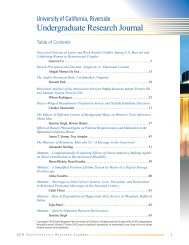2010 - Undergraduate Research, Scholarship and Creative Activity
2010 - Undergraduate Research, Scholarship and Creative Activity
2010 - Undergraduate Research, Scholarship and Creative Activity
Create successful ePaper yourself
Turn your PDF publications into a flip-book with our unique Google optimized e-Paper software.
Saving Riverside Chinatown: Redefining<br />
Identity in Asian-American Communities<br />
Chardae Chou, Media <strong>and</strong> Cultural Studies<br />
Christina Hwee, Political Science<br />
Kimberly Zarate, Anthropology/ Film <strong>and</strong><br />
Visual Culture<br />
Teresa Tran, English<br />
Donna Arkee, Anthropology<br />
Mentor: Scott Fedick<br />
Department of Anthropology<br />
the larger Asian Pacific Isl<strong>and</strong>er awareness<br />
movement forward.<br />
Cost Reduction Techniques for Proton<br />
Exchange Membrane Fuel Cells<br />
Christian Contreras, Chemical <strong>and</strong><br />
Environmental Engineering<br />
Mentor: Yushan Yan<br />
Department of Chemical <strong>and</strong> Environmental<br />
Engineering<br />
The First Transcontinental Railroad often st<strong>and</strong>s<br />
as the ―most‖ recognized historical contribution<br />
of the Chinese in America during the nineteenth<br />
century. As migration by these Chinese laborers<br />
increased, intensified ethnic discrimination of<br />
Chinese resulted in the institution of the Chinese<br />
Exclusion Act This act relocated thous<strong>and</strong>s of<br />
Chinese, forcing them to construct Chinatowns<br />
that collectively concentrated small groups of<br />
Chinese within larger communities—including<br />
Riverside, California. Although there are<br />
currently many educational opportunities in<br />
Riverside dedicated to Riverside's local history,<br />
preservation of the Chinatown site will ensure<br />
that future generations will have a more<br />
complete <strong>and</strong> visible perspective of early<br />
Riverside heritage <strong>and</strong> the historical<br />
contributions of the Chinese in Riverside. In<br />
2008, the Save Our Chinatown Committee<br />
(SOCC), a grassroots community organization,<br />
formed to oppose construction of a medical<br />
building on this local heritage site. Alongside<br />
this community organization, five SOCC student<br />
researchers worked in the areas of historical<br />
research, preservation research, public relations<br />
<strong>and</strong> community outreach. These interconnected<br />
arenas allow student communities <strong>and</strong> public<br />
organizations/entities to collaborate to preserve<br />
one of the last remaining archaeological<br />
Chinatown sites in the United States. Through<br />
experiential research, the students witnessed<br />
effects of community organizing among diverse<br />
groups <strong>and</strong> addressed movements to reclaim<br />
history <strong>and</strong> redefine identity in the Asian-<br />
American community. This presentation will<br />
address how community organizing among<br />
Asian-Americans indicates a social need for<br />
increased acknowledgment of Asian<br />
contributions in local history in order to propel<br />
Proton Exchange Membrane Fuel Cells<br />
(PEMFCs) have proven to be an alternative<br />
power source with little to no environmental<br />
repercussions. Unfortunately PEMFCs are<br />
commercially limited by the high cost of the<br />
components needed, including the catalyst. After<br />
implementing three separate projects, our<br />
laboratory developed three techniques to<br />
generate a better performing fuel cell. By<br />
improving the fabrication techniques for<br />
PEMFC‘s one can improve its performance <strong>and</strong><br />
decrease its cost. Through the use of an air brush<br />
technique, one can reduce the amount of catalyst<br />
on the Anode. Additionally by supporting<br />
Platinum on Multi-walled Carbon Nanotubes,<br />
<strong>and</strong> applying the same airbrush technique, one<br />
can reduce the amount of catalyst on the<br />
Cathode. Initial results show that decreasing the<br />
amount of catalyst used on the Anode by 90<br />
percent produces similar results to a st<strong>and</strong>ard<br />
Anode, while the Carbon nanotubes increase the<br />
Mass <strong>Activity</strong> of the Cathode by 800 percent.<br />
Combining these two techniques with a pretreatment<br />
of the Membrane Electrode Assembly<br />
with an Argon feed generates Nafion tm fibers<br />
(confirmed via SEM), increasing the<br />
performance by 25 percent. Each technique is<br />
aimed at improving the performance of a fuel<br />
cell <strong>and</strong> can be used in conjunction with one<br />
another. The results of these techniques show<br />
that the performance of a PEM Fuel Cell is<br />
increased while the cost of the catalyst required<br />
is decreased by 85 percent.<br />
Fourth Annual UCR Symposium for <strong>Undergraduate</strong> <strong>Research</strong>, <strong>Scholarship</strong> <strong>and</strong> <strong>Creative</strong> <strong>Activity</strong><br />
26














